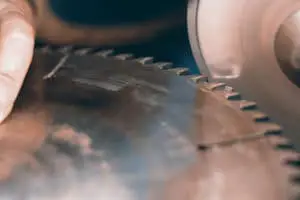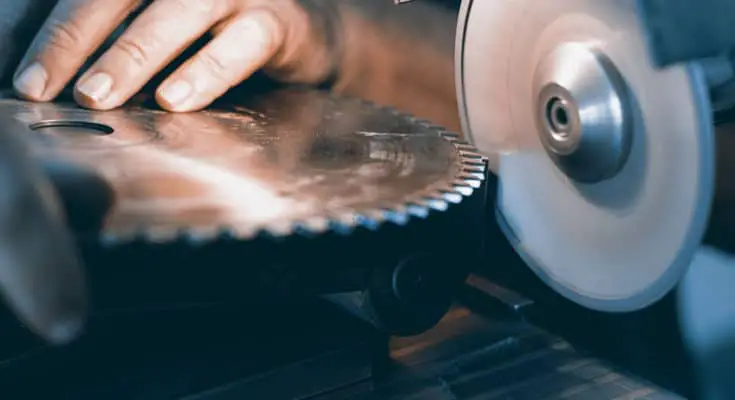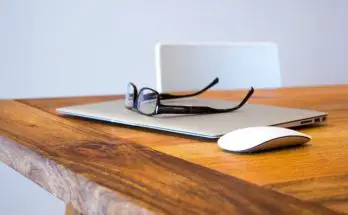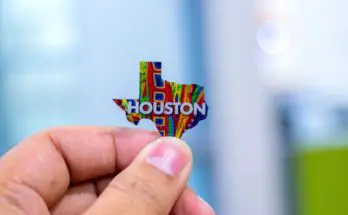If you do a significant amount of woodworking, you know that replacing saw blades can get expensive rather quickly. Personally, I feel like my band saw blades hold up rather well. But it feels like my circular saw and table saws are the blades that I’m replacing the most.
Can you sharpen a table saw blade? Yes, you can. There are DIY tools available for you to be able to do this. However, there’s other options available that might end up being better and more reliable.
What are table saw blades made of?
Today, table saw blades are generally made from one of two materials – stainless steel or carbide. The metal that your blades are made of will likely be the determining factor in whether you can sharpen them.
Stainless Steel – These blades are the cheapest made blades that you’ll find. Most of them can be picked up for under $20 and depending on the brand you can get more than one in a pack.
Carbide – Saw blades made from this metal are going to be a bit more expensive than Stainless Steel blades You can expect to pay somewhere in the $30-$40 range for a single blade for most brands.
The blade itself is made of steel, but the teeth are made of carbide which is a much harder metal. This helps the blade stay sharper for longer.
When it comes time to sharpen the blade, you’ll need to use a very strong abrasive, typically something that includes diamond bits.
DIY Options
When sharpening your table saw blades, it is very important to ensure that the angles of the teeth on your blades remain the same. Not keeping your teeth in the same geometric shape can cause issues down the road when you go to cut your next piece of wood.
To help with the process of sharpening your own table saw blades, I encourage you to either buy a tool that aligns everything for you or build a jig.
Build a jig
As with most jigs that you find online there are numerous different designs available. The easiest jig that I found involves picking up a set of diamond honing sticks from Amazon. You then prop the honing stick to a piece of wood that is angled at 20 degrees. You then slightly rub each tooth on your blade with the honing stick to sharpen it. TIP – Make sure you mark the tooth you start with so you know when to stop!
Here’s a video demonstrating the method
[embedyt] https://www.youtube.com/watch?v=HVxHa-4X2YQ[/embedyt]
Sharpening Tools
Surprisingly, there aren’t many options available when it comes to DIY tools for you to sharpen your own table saw blades. The only option that I have found is the Chicago Electric Blade Sharpener at Harbor Freight. It runs about $50, but you can catch it on sale often.
Blade Sharpening Services
The final option available to those wanting to have their table saw blades sharpened is to send them off. Having a professional do the work  will ensure that the blades are sharpened correctly. The machinery that the professionals use are very precise and will return your blades back to like new condition.
will ensure that the blades are sharpened correctly. The machinery that the professionals use are very precise and will return your blades back to like new condition.
This option can be pricey. On average, a shop will charge 25 to 50 cents PER TOOTH to sharpen a table saw blade. If your blade has 80 teeth, you’re going to be looking at $20 to $40 before shipping costs.
At this price, it’s not worth the cost to sharpen cheap blades. I would recommend going with one of the DIY options mentioned above. However, if you have an expensive blade, sending it off to a professional for sharpening is the best option.
Check your local metal shops if you prefer avoiding the hassle of mailing your blades to someone. A good online source that I found to send your blades to someone is www.burnstools.com
How do I know my blades need to be sharpened?
The easiest way to tell that it’s time to replace or sharpen your blades is by the type of cut you are getting from your saw. If you are starting to see that it takes more time for your blade to cut thru wood, it’s likely it’s time for a new blade.
Another visible way to tell that it might be time to change blades is if you start noticing burn marks on your wood. This sometime indicates the blade is burning the wood and not cutting properly.
If you do see burn marks on the wood you are cutting, you may want to check out an article I wrote on this subject as it’s not always the result of a dull blade. You can find my article here.
Closing
Hopefully this article has informed you of some options available to you for sharpening your blades. Taking the time to sharpen your blades will certainly save you money in the long run.
If you have any additional tips or suggestions on blade sharpening, please leave a comment below!




